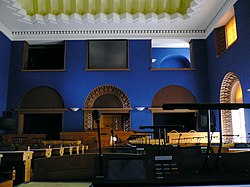Eugen Habermann
Eugen Habermann (born October 7 . Jul / 19th October 1884 greg. In Tallinn ; † 17th September 1944 in the Gulf of Gdansk ) was an Estonian architect .
Early years
Eugen Habermann studied at the Riga Polytechnic Institute from 1902 to 1905 and at the Dresden Technical University from 1906 to 1909 . From 1909 to 1912 he worked in Dresden , Saxony , 1910/1911 in Liepāja in Courland and from 1913 in Tallinn, Estonia.
In 1913 Habermann was construction manager at the Estonia Concert and Opera House . From 1914 to 1923 Habermann worked as the city architect of Tallinn. From 1919 to 1923 he was also head of the building department in the Estonian Ministry of the Interior. From 1922 to 1932 Eugen Habermann was the first chairman of the Estonian Architects' Association ( Eesti Arhitektide Ühing ).
Architect in Tallinn
As an architect, Eugen Habermann has left numerous traces in Tallinn. Between 1917 and 1920 he played a decisive role in the town planning of Tallinn. Together with Herbert Voldemar Johanson , he designed the building of the Estonian Parliament ( Riigikogu ) on the site of the ruins of the former convent house on Toompea. It was the first representative building of the new Estonian state. The building is based on two different styles: traditionalism or late Art Nouveau of the 1920s on the outside and expressionism on the inside. It is the only expressionist-style parliament building in the world.
In the second half of the 1920s, his style became more functionalist . Date from that time
- Rauaniit - jersey factory , 1926–1932 (Tallinn, Põhja puiestee 7)
- Electricity company, 1928–1932 (Tallinn, Põhja puiestee 27)
- Commercial and residential building, 1932/1933 (Tallinn, Pärnu maantee 6)
- Headquarters of Eesti Pank , 1935 (Tallinn, Estonia puiestee 13, together with Herbert Voldemar Johanson)
- House, 1939 (Tallinn, Roosikrantsi 8 / 8a)
Individual evidence
- ↑ Entry in the baptismal register of the Karlskirche zu Reval (Estonian: Tallinna Kaarli kirik)
- ↑ Eesti elulood. Tallinn: Eesti entsüklopeediakirjastus 2000 (= Eesti entsüklopeedia 14) ISBN 9985-70-064-3 , p. 77
- ↑ http://www.riigikogu.ee/?id=33278
| personal data | |
|---|---|
| SURNAME | Habermann, Eugene |
| BRIEF DESCRIPTION | Estonian architect |
| DATE OF BIRTH | October 19, 1884 |
| PLACE OF BIRTH | Tallinn |
| DATE OF DEATH | September 17, 1944 |
| Place of death | Gdańsk Bay |
